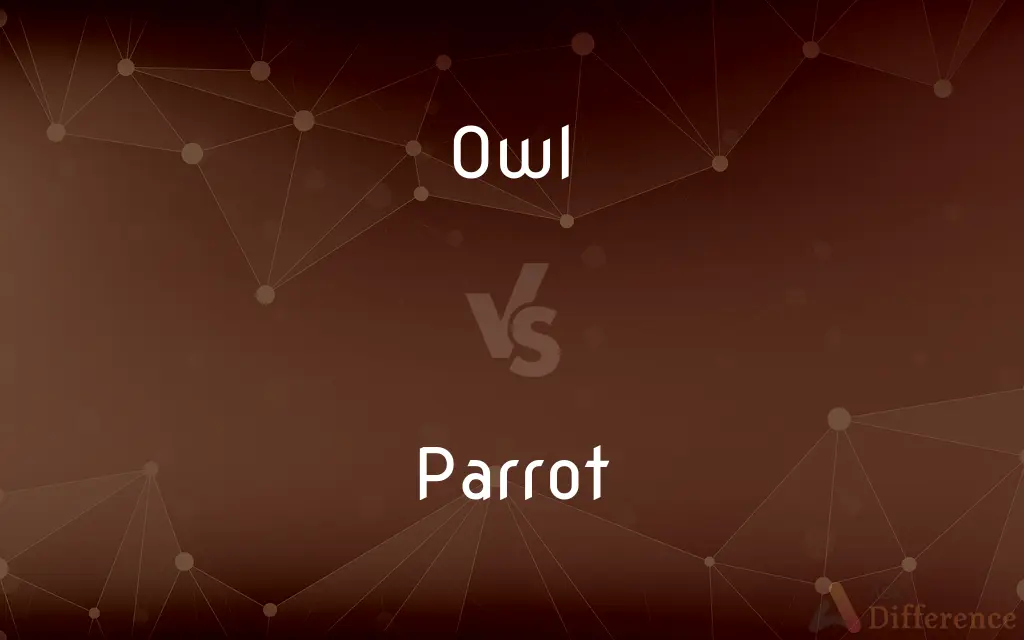Owl vs. Parrot — What's the Difference?
By Tayyaba Rehman & Maham Liaqat — Updated on April 3, 2024
Owls are known for their silent flight and nocturnal habits, focusing on hunting at night, while parrots are colorful, social birds, often active during the day and known for their ability to mimic sounds.

Difference Between Owl and Parrot
Table of Contents
ADVERTISEMENT
Key Differences
Owls are primarily nocturnal birds of prey with keen eyesight and hearing, adapted for hunting in darkness. They have a distinctive facial disk that funnels sound to their ears, aiding in locating prey. On the other hand, parrots are known for their vibrant plumage and strong, curved beaks, thriving in daylight hours. They possess a remarkable ability to mimic sounds and human speech, which, along with their social nature, makes them popular as pets.
Owls have a unique flying ability that allows them to fly silently, making it easier to sneak up on their prey during the night. This silent flight is enabled by their specialized feather structure. Whereas parrots are not known for silent flight but are agile fliers with strong wing muscles for fast, direct flight, important for escaping predators and moving between feeding sites during the day.
The diet of an owl mainly consists of small mammals, insects, and other birds, reflecting their role as nocturnal predators. Their hunting strategy and physical adaptations are centered around this diet. Parrots, however, mainly feed on seeds, nuts, fruit, and sometimes insects, using their powerful beaks to break open hard shells, a testament to their adaptation to varied environments.
Breeding habits of owls involve using existing structures like tree holes, abandoned nests, or even the ground for nesting, often in solitary pairs. Owls are less visibly social compared to parrots. Parrots, in contrast, may form large communal nesting sites and are known for their complex social structures and bonding behaviors, including monogamous relationships that can last a lifetime.
In terms of habitat, owls are found in a variety of environments, from forests to deserts, adapting to local conditions primarily for hunting. Parrots are mostly found in tropical and subtropical regions, with their bright colors and dietary habits reflecting the biodiversity of these ecosystems.
ADVERTISEMENT
Comparison Chart
Activity Time
Nocturnal, active at night
Diurnal, active during the day
Diet
Carnivorous: small mammals, insects, birds
Omnivorous: seeds, nuts, fruit, insects
Social Behavior
Solitary or in pairs, less visibly social
Highly social, forms large groups, monogamous relationships
Vocalization
Hooting, screeching, silent during hunting
Mimic sounds, human speech, vocal in communication
Flight
Silent due to specialized feathers
Not silent, strong and fast due to muscular wings
Compare with Definitions
Owl
Feeds on small mammals and insects, using keen senses.
An owl can hear a mouse stepping on a twig from a distance.
Parrot
Primarily found in tropical and subtropical regions.
Parrots add to the vibrant biodiversity of rainforests.
Owl
Nocturnal bird of prey with a flat face and large eyes.
The owl hooted from its perch in the dark forest.
Parrot
Eats seeds, nuts, and fruit, using their beak for feeding.
Parrots gathered in the tree, feasting on fruits.
Owl
Known for silent flight enabled by soft-edged feathers.
The owl swooped down on its prey silently.
Parrot
Forms large social groups, often with lifelong partners.
Those parrots have been companions for years.
Owl
Solitary or in pairs, using existing structures for nests.
The pair of owls nested in the abandoned barn.
Parrot
Brightly colored, social bird with a strong, curved beak.
The parrot cracked open a nut with its beak.
Owl
Found in diverse habitats worldwide.
Owls are adaptable birds, living from forests to deserts.
Parrot
Known for their ability to mimic sounds and speech.
The parrot amused everyone by mimicking the telephone ring.
Owl
Owls are birds from the order Strigiformes , which includes over 200 species of mostly solitary and nocturnal birds of prey typified by an upright stance, a large, broad head, binocular vision, binaural hearing, sharp talons, and feathers adapted for silent flight. Exceptions include the diurnal northern hawk-owl and the gregarious burrowing owl.
Parrot
Parrots, also known as psittacines , are birds of the roughly 398 species in 92 genera comprising the order Psittaciformes , found mostly in tropical and subtropical regions. The order is subdivided into three superfamilies: the Psittacoidea ("true" parrots), the Cacatuoidea (cockatoos), and the Strigopoidea (New Zealand parrots).
Owl
Any of various often nocturnal birds of prey of the order Strigiformes, having hooked and feathered talons, a large head with a short hooked beak, large eyes set forward, and fluffy plumage that allows for almost noiseless flight.
Parrot
Any of numerous primarily tropical and subtropical birds of the order Psittaciformes, characterized by a short hooked bill, brightly colored plumage, and, in some species, the ability to mimic human speech or other sounds.
Owl
Any of several breeds of domestic pigeons having a very short beak somewhat like that of an owl and often a frill of feathers on the chest.
Parrot
One who imitates the words or actions of another, especially without understanding them.
Owl
Any of various birds of prey of the order Strigiformes that are primarily nocturnal and have forward-looking, binocular vision, limited eye movement, and good hearing.
Parrot
To repeat or imitate, especially without understanding.
Owl
(by extension) A person seen as having owl-like characteristics, especially appearing wise or serious, or being nocturnally active.
Parrot
A kind of bird, many species of which are colorful and able to mimic human speech, of the order Psittaciformes or (narrowly) of the family Psittacidae.
I bought a wonderful parrot at the pet store.
Owl
An owl pigeon.
Parrot
A parroter; a person who repeats the words or ideas of others.
What kind of a parrot are you? He just said that.
Owl
A politician with moderate views that are neither hawkish nor dovish.
Parrot
(archaic) A puffin.
Owl
Any of various nymphalid butterflies, especially in the genus Caligo, having large eyespots on the wings.
Parrot
Channel coal.
Owl
To smuggle contraband goods.
Parrot
A transponder.
Owl
Any species of raptorial birds of the family Strigidæ. They have large eyes and ears, and a conspicuous circle of feathers around each eye. They are mostly nocturnal in their habits.
Parrot
(transitive) To repeat (exactly what has just been said) without necessarily showing understanding, in the manner of a parrot.
The interviewee merely parroted the views of her tabloid.
Owl
A variety of the domestic pigeon.
Parrot
In a general sense, any bird of the order Psittaci.
Owl
To pry about; to prowl.
Parrot
Any species of Psittacus, Chrysotis, Pionus, and other genera of the family Psittacidæ, as distinguished from the parrakeets, macaws, and lories. They have a short rounded or even tail, and often a naked space on the cheeks. The gray parrot, or jako (Psittacus erithacus) of Africa (see Jako), and the species of Amazon, or green, parrots (Chrysotis) of America, are examples. Many species, as cage birds, readily learn to imitate sounds, and to repeat words and phrases.
Owl
To carry wool or sheep out of England.
Parrot
To repeat by rote, without understanding, as a parrot.
Owl
Hence, to carry on any contraband trade.
Parrot
To chatter like a parrot.
Owl
Nocturnal bird of prey with hawk-like beak and claws and large head with front-facing eyes
Parrot
Usually brightly colored zygodactyl tropical birds with short hooked beaks and the ability to mimic sounds
Parrot
A copycat who does not understand the words or acts being imitated
Parrot
Repeat mindlessly;
The students parroted the teacher's words
Common Curiosities
Can parrots really talk like humans?
Parrots can mimic human speech and sounds but don't understand the language.
What makes an owl's flight silent?
Owls have specialized feathers that muffle sound, allowing them to approach prey quietly.
What do parrots eat?
Parrots mainly eat seeds, nuts, fruits, and occasionally insects.
How long do owls typically live?
The lifespan of an owl can vary widely among species, some living more than 20 years in the wild.
What are the common predators of owls?
Larger birds of prey and certain mammals can predate on owls.
Are owls solitary animals?
Yes, owls are generally solitary but may pair up during breeding season.
How do parrots communicate?
Parrots use vocalizations and body language to communicate with each other.
Can owls turn their heads all the way around?
Owls can rotate their heads up to 270 degrees thanks to their flexible necks.
Where do owls live?
Owls can live in a variety of habitats, including forests, deserts, and urban areas.
Why are parrots so colorful?
The bright colors of parrots may play a role in communication and mate selection.
Are parrots endangered?
Many parrot species are threatened or endangered due to habitat loss and the pet trade.
What is the significance of an owl's large eyes?
Owls have large eyes to improve their night vision, crucial for hunting in darkness.
Do parrots have good memory?
Yes, parrots are known for their excellent memory, especially for sounds.
How do owls hunt?
Owls hunt by using their keen senses to detect prey at night and silently swooping down to catch it.
What kind of social structure do parrots have?
Parrots often live in large, complex social groups and can form monogamous relationships.
Share Your Discovery

Previous Comparison
Planning vs. Implementation
Next Comparison
Quarterfinal vs. SemifinalAuthor Spotlight
Written by
Tayyaba RehmanTayyaba Rehman is a distinguished writer, currently serving as a primary contributor to askdifference.com. As a researcher in semantics and etymology, Tayyaba's passion for the complexity of languages and their distinctions has found a perfect home on the platform. Tayyaba delves into the intricacies of language, distinguishing between commonly confused words and phrases, thereby providing clarity for readers worldwide.
Co-written by
Maham Liaqat















































